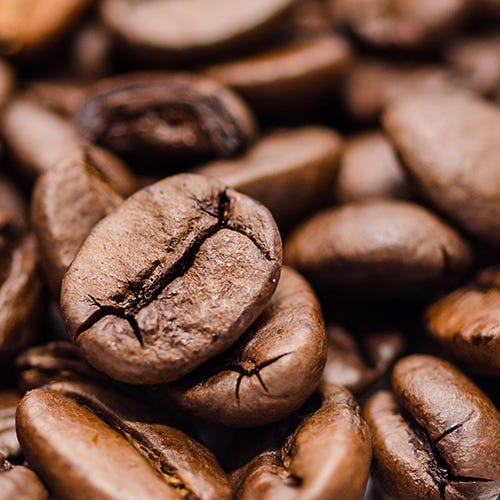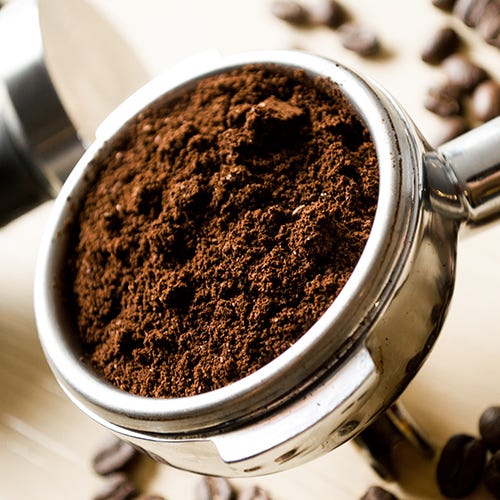Let's talk Coffee
Categories:
Once again our guest blogger this week is Mark Hartstone from La Fosseat Cranborne in Dorset. Mark talks about his relationship as a chef with coffee and through his experience how to choose and make the perfect cup. So put your feet up, make yourself a nice brew and enjoy the read.
Coffee
It is all very confusing, and starts with the bean that is not really a bean but a seed (stone) from a cherry type fruit. Indigenous originally to the Ethiopian high lands, modern day plantations around the world now make it a global business. Usually there are two stones in a fruit but 10% or so have one that is spherical and called a pea. So you also have coffee pea beans that are neither beans or peas! Why am I as a chef writing about coffee? Most people in the hospitality trade have a very close relationship with coffee, more to do with the caffeine and long hours rather than a deep interest in the dark brew! This month I have drunk more coffee than ever before, not to stay awake but over several days judging for the Great Taste Awards. Trying up to 20 espressos a day gives a great insight to coffee making and the varied flavour profiles. A trip to see our coffee roaster Giles of Reeds Coffee in Sherborne has also highlighted the skills to produce a good cup. Seeing how our ingredients get produced for the Restaurant at La Fosse is very important to us and really helps with understanding how to make the most out of them and makes it easier to spread the word of our great local producers. So how to make a great coffee? This is not as easy as it sounds. There are many types of coffee out there like grapes for wine, hence vocabulary describing them can be a bit Jilly Goolden, with words and phrases like burnt toast/tyres/rubber, honeyed notes, chocolaty, floral, fruits of the forest. The trick is to find the producer who is able to create the right blend for you. Think whisky - there are lots of very pleasant blends out there which you can drink on the rocks or as a long cocktail, however for fantastic character you go to a single malt. Single estate coffees too vary in style and are not everyone's cup of tea! The 2 main types of coffee are the Robusta and the Arabica, the former lives up to its name in flavour and how it grows, whereas the Arabica is usually associated with better quality coffee. Different coffees lend themselves to varying styles of drink - long and milky, like flat whites, cappuccinos (but never order after midday in Italy if you want to be well thought of), or americano the espresso with hot water added. You can enjoy real coffee from
with the bean that is not really a bean but a seed (stone) from a cherry type fruit. Indigenous originally to the Ethiopian high lands, modern day plantations around the world now make it a global business. Usually there are two stones in a fruit but 10% or so have one that is spherical and called a pea. So you also have coffee pea beans that are neither beans or peas! Why am I as a chef writing about coffee? Most people in the hospitality trade have a very close relationship with coffee, more to do with the caffeine and long hours rather than a deep interest in the dark brew! This month I have drunk more coffee than ever before, not to stay awake but over several days judging for the Great Taste Awards. Trying up to 20 espressos a day gives a great insight to coffee making and the varied flavour profiles. A trip to see our coffee roaster Giles of Reeds Coffee in Sherborne has also highlighted the skills to produce a good cup. Seeing how our ingredients get produced for the Restaurant at La Fosse is very important to us and really helps with understanding how to make the most out of them and makes it easier to spread the word of our great local producers. So how to make a great coffee? This is not as easy as it sounds. There are many types of coffee out there like grapes for wine, hence vocabulary describing them can be a bit Jilly Goolden, with words and phrases like burnt toast/tyres/rubber, honeyed notes, chocolaty, floral, fruits of the forest. The trick is to find the producer who is able to create the right blend for you. Think whisky - there are lots of very pleasant blends out there which you can drink on the rocks or as a long cocktail, however for fantastic character you go to a single malt. Single estate coffees too vary in style and are not everyone's cup of tea! The 2 main types of coffee are the Robusta and the Arabica, the former lives up to its name in flavour and how it grows, whereas the Arabica is usually associated with better quality coffee. Different coffees lend themselves to varying styles of drink - long and milky, like flat whites, cappuccinos (but never order after midday in Italy if you want to be well thought of), or americano the espresso with hot water added. You can enjoy real coffee from the simplicity of a cafetiere, or single cup filter which will let you taste the nuances of your coffee, these require minimal equipment/investment. Harts of Stur stock a great range. However if you like the intense short espressos or the range of coffees that use the espresso as base then you can either get a stove top moka pot or an aeropress that is a plastic gadget that works like a piston with sheer brute force! Both work well but are not to everyone's taste. The other route is a coffee machine either using pre-ground or grinding to order or there are ones that work with pods. The size of the machine is really dependent on how many coffees you are wanting to make. The handles with the coffee baskets are sticking out of the machine are called groups, and for a domestic situation this is all you need as you tend to use one at a time. The biggest issue is the warm up time, the Sage Barista Expressis very quick. It is also possible to put a time clock on the power supply of some coffee machines so the boiler has time to heat up for your morning brew.
the simplicity of a cafetiere, or single cup filter which will let you taste the nuances of your coffee, these require minimal equipment/investment. Harts of Stur stock a great range. However if you like the intense short espressos or the range of coffees that use the espresso as base then you can either get a stove top moka pot or an aeropress that is a plastic gadget that works like a piston with sheer brute force! Both work well but are not to everyone's taste. The other route is a coffee machine either using pre-ground or grinding to order or there are ones that work with pods. The size of the machine is really dependent on how many coffees you are wanting to make. The handles with the coffee baskets are sticking out of the machine are called groups, and for a domestic situation this is all you need as you tend to use one at a time. The biggest issue is the warm up time, the Sage Barista Expressis very quick. It is also possible to put a time clock on the power supply of some coffee machines so the boiler has time to heat up for your morning brew.
Quick Coffee Tips
- Pre-ground coffee loses its aromatics quickly, so grinding your own in small batches to order keeps the flavour. A cool dark place with as little air getting to the coffee is the best way to keep it fresh. Refrigerating it or freezing it will potentially cause problems with moisture spoiling the coffee.
- Darker roasts tend to mean a stronger flavour, though too dark and an oil slick or burnt tyre flavour comes to the fore.
Main things that alter the coffee other than the type of bean
- The grind of the beans - the coarser the grains reduces the time for the water or steam to pass through and absorb the flavour.
- Pressure to force water through the grind, the greater the pressure the quicker for the liquid/steam to pass through the grains, 15 seconds for an espresso is quite normal, over 20 and there will be muddy bitter notes and under 10 seconds it will struggle to capture the full flavour.
- Amount of coffee used permits extra flavour, though too much can stop the water from passing through altogether.
- Temperature - just under the boil is the ideal temperature, too cool and it will be like dish water and too hot is no good either.
- The water itself does play a part, if the water has been over boiled all the oxygen will come out of it and it this will create a duller flavour - strange but true.
Once you have mastered your coffee making at home have a look at alfresco coffee making. Harts of Stur also do a great range of flasks or thermal cups and gadgets that mean you can have great coffee on the go too. Do not put up with mediocrity from paper/polystyrene cups at service stations!
